
History of Amsterdam
Encyclopedia
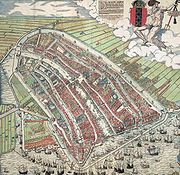
.jpg)
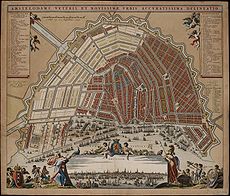

Amsterdam
Amsterdam is the largest city and the capital of the Netherlands. The current position of Amsterdam as capital city of the Kingdom of the Netherlands is governed by the constitution of August 24, 1815 and its successors. Amsterdam has a population of 783,364 within city limits, an urban population...
has a long and eventful history. The origins of the city lie in the 13th century, when fisherman living along the banks of the River Amstel built a bridge across the waterway near the IJ, then a large saltwater inlet. Wooden doors on the bridge served as a dam; these protected the town from the IJ, which often flooded the early settlement. The mouth of the river Amstel
Amstel
The Amstel is a river in the Netherlands which runs through the city of Amsterdam. The river's name is derived from Aeme stelle, old Dutch for "area abounding with water"....
, where the Damrak
Damrak
The Damrak is a partially filled in canal at the centre of Amsterdam, between Amsterdam Centraal railway station and Dam Square, running north-south. It is the main street where people arriving at the station enter the centre of Amsterdam. Also it is one of the two GVB tram routes from the station...
now is, formed a natural harbor, which became important for trade.
The oldest document that refers to the settlement of Aemstelledamme 'dam on the Amstel', as it was then known, is dated 1204 AD.
Medieval feudality

A more important year in the history of Amsterdam was 1275. While Amstelland fell under the administrative jurisdiction of the Prince-bishop's Sticht Utrecht
Utrecht (province)
Utrecht is the smallest province of the Netherlands in terms of area, and is located in the centre of the country. It is bordered by the Eemmeer in the north, Gelderland in the east, the river Rhine in the south, South Holland in the west, and North Holland in the northwest...
, Count Floris V of Holland granted the fishmen exemption from tolls. This document, dated 27 October, is the oldest recorded usage of the name "Amsterdam". This meant the inhabitants in the vicinity of Amestelledamme had right to travel through the county Holland without having to pay toll. After the murder of Floris in 1296, Amstelland again belonged to the Sticht. By 1327, the name had developed into Aemsterdam.
Around 1300, Gwijde van Henegouwen, bishop of Utrecht, gave Amsterdam city rights
City rights in the Netherlands
City rights are a medieval phenomenon in the history of the Low Countries. A liegelord, usually a count, duke or similar member of high nobility, granted a settlement he owned certain town privileges that settlements without city rights did not have....
. After his death, Count Willem III
William I, Count of Hainaut
William I, Count of Hainaut was Count William III of Avesnes, Count William III of Holland and Count William II of Zeeland from 1304 to his death...
inherited Amstelland, upon which Amsterdam thenceforth fell under Holland.
In 1323, Willem III established a toll on the trade of beer from Hamburg
Hamburg
-History:The first historic name for the city was, according to Claudius Ptolemy's reports, Treva.But the city takes its modern name, Hamburg, from the first permanent building on the site, a castle whose construction was ordered by the Emperor Charlemagne in AD 808...
. The contacts laid through the beer trade formed the basis for subsequent trade with cities of the Hanseatic league
Hanseatic League
The Hanseatic League was an economic alliance of trading cities and their merchant guilds that dominated trade along the coast of Northern Europe...
in the Baltic Sea
Baltic Sea
The Baltic Sea is a brackish mediterranean sea located in Northern Europe, from 53°N to 66°N latitude and from 20°E to 26°E longitude. It is bounded by the Scandinavian Peninsula, the mainland of Europe, and the Danish islands. It drains into the Kattegat by way of the Øresund, the Great Belt and...
, from where during the 14th and 15th centuries the Amsterdammers increasingly acquired grain and timber. In 1342, Count Willem IV awarded the city "Groot Privilege", which greatly strengthened the position of the city. During the 15th century, Amsterdam became the granary of the northern low countries and the most important trading city in Holland.
According to legend, on 12 March 1345, the miracle of Amsterdam occurred and Amsterdam became an important pilgrimage town. The town grew considerably thanks to the pilgrims. A Roman Catholic procession (Stille Omgang
Stille Omgang
A stille omgang is an informal ritual that served as substitute for the Roman Catholic processions that were prohibited after the Reformation in the Netherlands in the 16th century...
) occurs every year to celebrate the miracle.
Two great fires swept through the city in 1421 and 1452. After the second, where three quarters of the city were destroyed, Emperor Charles decreed that new houses were to be built from stone. Few wooden building remain from this period, a notable exception being the Houten Huis (Wooden House) at the Begijnhof
Begijnhof, Amsterdam
The Begijnhof is one of the oldest inner courts in the city of Amsterdam. A group of historic buildings, mostly private dwellings, centre on it. As the name suggests, it was originally a Béguinage...
.
Conflict with Spain
The 16th century brought a rebellion by the Dutch against the Habsburg king Philip II of SpainPhilip II of Spain
Philip II was King of Spain, Portugal, Naples, Sicily, and, while married to Mary I, King of England and Ireland. He was lord of the Seventeen Provinces from 1556 until 1581, holding various titles for the individual territories such as duke or count....
. The uprising was mainly caused by the lack of political power for the local nobility and by the religious intolerance of the Spanish. Although Amsterdam began the war on the Spanish side, it changed sides in 1578 and gave its support to William I of Orange. The rebellion led to the Eighty Years' War and Dutch independence.
One of the results of the war was that Spanish religious intolerance gave way to Dutch tolerance. In Amsterdam people were free to believe what they wanted (within certain limits). In the city a large Roman Catholic minority remained (and Roman Catholicism is still one of the major religions in Amsterdam), but the majority of the people belonged to the Reformed Church and other Protestant denominations.
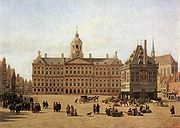
The "Golden Age" (1585-1672)
The 17th century was Amsterdam's Golden Age. Ships from the city sailed to North America, Indonesia, Brazil and Africa and formed the basis of a worldwide trading network. Amsterdam's merchants financed expeditions to the four corners of the world and they acquired the overseas possessions which formed the seeds of the later Dutch colonies. Rembrandt painted in this century,and the city expanded greatly around its canals during this time. Amsterdam was the most important point for the transshipment of goods in Europe and it was the leading financial centre of the world (a position later taken over by London).Government by regents
By the mid-1660s Amsterdam had reached the optimum population (about 200,000) for the level of trade, commerce and agriculture then available to support it. The city contributed the largest quota in taxes to the States of Holland which in turn contributed over half the quota to the States General. Amsterdam was also one of the most reliable in settling tax demands and therefore was able to use the threat to withhold such payments to good effect.Amsterdam was governed by a body of regents, a large, but closed, oligarchy with control over all aspects of the city's life, and a dominant voice in the foreign affairs of Holland. Only men with sufficient wealth and a long enough residence within the city could join the ruling class. The first step for an ambitious and wealthy merchant family was to arrange a marriage with a long-established regent family. In the 1670s one such union, that of the Trip family (the Amsterdam branch of the Swedish arms makers) with the son of Burgomaster Valckenier, extended the influence and patronage available to the latter and strengthened his dominance of the council. The oligarchy in Amsterdam thus gained strength from its breadth and openness. In the smaller towns family interest could unite members on policy decisions but contraction through intermarriage could lead to the degeneration of the quality of the members. In Amsterdam the network was so large that members of the same family could be related to opposing factions and pursue widely separated interests. The young men who had risen to positions of authority in the 1670s and 1680s consolidated their hold on office well into the 1690s and even the new century.
Amsterdam's regents provided good services to residents. They spent heavily on the water-ways and other essential infrastructure, as well as municipal almshouses for the elderly, hospitals and churches.
Amsterdam's wealth was generated by its commerce, which was in turn sustained by the judicious encouragement of entrepreneurs whatever their origin. This open door policy has been interpreted as proof of a tolerant ruling class. But toleration was practiced for the convenience of the city. Therefore the wealthy Sephardic Jews from Portugal were welcomed and accorded all privileges except those of citizenship, but the poor Ashkenazi Jews from Eastern Europe were far more carefully vetted and those who became dependent on the city were encouraged to move on. Similarly, provision for the housing of Huguenot immigrants was made in 1681 when Louis XIV's religious policy was beginning to drive these Protestants out of France; no encouragement was given to the dispossessed Dutch from the countryside or other towns of Holland. The regents encouraged immigrants to build churches and provided sites or buildings for churches and temples for all but the most radical sects and the native Catholics by the 1670s (although even the Catholics could practice quietly in a chapel within the Beguinhof).
Immigration
During the 17th and 18th century, Amsterdam was a city where immigrants formed the majority. Most immigrants were Lutheran-Protestant Germans. The enormous impact of German immigration can be seen nowadays in the surnames, which are often German. The integration of immigrants was smooth. It was not hard to find work as a craftsman, but craftsmen were forced to join guilds, to serve in the city patrol and to cooperate in the local district to compete with other districts. These were powerful institutions that resulted in quick integration, especially since all these institutions were mainly filled with immigrants or children of immigrants. The city council of Amsterdam consisted out of people with all kinds of backgrounds: Dutch, German, Flemish, French, Scottish.Plague
However, the city's trading status meant it suffered from an outbreak of bubonic plagueBubonic plague
Plague is a deadly infectious disease that is caused by the enterobacteria Yersinia pestis, named after the French-Swiss bacteriologist Alexandre Yersin. Primarily carried by rodents and spread to humans via fleas, the disease is notorious throughout history, due to the unrivaled scale of death...
from 1663 to 1666, supposed to have come from Algiers
Algiers
' is the capital and largest city of Algeria. According to the 1998 census, the population of the city proper was 1,519,570 and that of the urban agglomeration was 2,135,630. In 2009, the population was about 3,500,000...
to Amsterdam. (The plague also broke out in the trading centre of London
Great Plague of London
The Great Plague was a massive outbreak of disease in the Kingdom of England that killed an estimated 100,000 people, 20% of London's population. The disease is identified as bubonic plague, an infection by the bacterium Yersinia pestis, transmitted through a flea vector...
in June 1665.) Though it had little initial effect, the impact grew in autumn 1663 and in 1664. Jan J. Hinlopen's wife and youngest daughter, along with Rembrandt's partner Hendrickje Stoffels
Hendrickje Stoffels
Hendrickje Stoffels was a model and mistress of Rembrandt.-Youth:Hendrickje was born in the garrison city of Bredevoort, Gelderland, the daughter of sergeant Stoffel Stoffelse and Mechteld Lamberts...
, fell victim to it that autumn. According to Samuel Pepys
Samuel Pepys
Samuel Pepys FRS, MP, JP, was an English naval administrator and Member of Parliament who is now most famous for the diary he kept for a decade while still a relatively young man...
, for a few weeks at the end of 1663 ships from Hamburg and Amsterdam were quarantined for thirty days. In 1664, 24,148 people were buried in Amsterdam and people assumed the plague was caused by the digging of new canals. More than 10% of the population died in this period - everybody that came into contact with the plague was at risk.
Surprisingly, tobacco smoke was regarded as an effective prophylactic against the plague. With the prospect of the plague, as well as war with England looming, the English ambassador commented in May 1664: there are dead this last weeke to the number 338 at Amsterdam and if the plague thus increases within, and a warre with His Majestie without, there will be little need of that vast new towne which they are making there. Rich people left the cities to avoid the disease, but in the worst week of the pandemic in 1664 in Amsterdam there were 1,041 burials compared with 7,000 in the late summer of 1665 in London, a city twice its size. The mayors warned the population that eating salad, spinach or prunes could be unhealthy. The vroedschap
Vroedschap
The vroedschap was the name for the city council in the early modern Netherlands; the member of such a council was called a vroedman, literally a "wise man"...
shut the theatre, allowing performances to resume only in 1666, though Jan J. Hinlopen's own death in 1666 is ascribed to the plague. Sailors on ships out to sea were relatively safe.
Decline and modernization

Samuel Sarphati
Samuel Sarphati was a Dutch physician and Amsterdam city planner.- Biography :Sarphati's ancestors were Portuguese Sephardi Jews who arrived in the Netherlands in the 17th century. While only middle-class, his parents were able to let him attend a Latin school...
who found their inspiration in Paris.
At the end of the 19th century the Industrial Revolution
Industrial Revolution
The Industrial Revolution was a period from the 18th to the 19th century where major changes in agriculture, manufacturing, mining, transportation, and technology had a profound effect on the social, economic and cultural conditions of the times...
reached Amsterdam. The Amsterdam-Rijn kanaal was dug to give Amsterdam a direct connection to the Rhine and the Noordzee kanaal to give the port a connection with the North Sea
North Sea
In the southwest, beyond the Straits of Dover, the North Sea becomes the English Channel connecting to the Atlantic Ocean. In the east, it connects to the Baltic Sea via the Skagerrak and Kattegat, narrow straits that separate Denmark from Norway and Sweden respectively...
. Both projects improved communication with the rest of Europe and the world dramatically. They gave the economy a big boost.
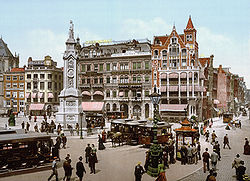
The end of the 19th century is sometimes called Amsterdam's second Golden Age. New museums, the Centraal Station and the Concertgebouw
Concertgebouw
The Concertgebouw is a concert hall in Amsterdam, Netherlands. The Dutch term "concertgebouw" literally translates into English as "concert building"...
were built. Also built was the Stelling van Amsterdam
Stelling van Amsterdam
The UNESCO World Heritage Site known as the Defence Line of Amsterdam is a 135 km long ring of fortifications around Amsterdam, consisting of 42 forts located between 10 to 15 kilometers the centre, and lowlands that can easily be flooded in time of war...
, a unique ring of 42 forts and land that could be inundated to defend the city against an attack. Amsterdam's population grew significantly during this period.
20th century
During World War I, the Netherlands remained neutral, but Amsterdam suffered the effects of the war when food became scarce. When working class women started to plunder a ship with army supplies, the military was brought in. Workers joined their wives in the plundering and the soldiers opened fire on them. Six people were killed and almost 100 were wounded.In 1932 a dike separating the Zuider Zee
Zuider Zee
The Zuiderzee was a shallow bay of the North Sea in the northwest of the Netherlands, extending about 100 km inland and at most 50 km wide, with an overall depth of about 4 to 5 metres and a coastline of about 300 km . It covered...
from the North Sea
North Sea
In the southwest, beyond the Straits of Dover, the North Sea becomes the English Channel connecting to the Atlantic Ocean. In the east, it connects to the Baltic Sea via the Skagerrak and Kattegat, narrow straits that separate Denmark from Norway and Sweden respectively...
, the Afsluitdijk
Afsluitdijk
The Afsluitdijk is a major causeway in the Netherlands, constructed between 1927 and 1933 and running from Den Oever on Wieringen in North Holland province, to the village of Zurich in Friesland province, over a length of and a width of 90 m, at an initial height of 7.25 m above sea-level.It is...
, was completed. The Zuider Zee was no more. The new lake behind the dyke was called IJsselmeer
IJsselmeer
IJsselmeer is a shallow artificial lake of 1100 km² in the central Netherlands bordering the provinces of Flevoland, North Holland and Friesland, with an average depth of 5 to 6 m. The IJsselmeer is the largest lake in Western Europe....
. For the first time in its history Amsterdam had no open communication with the sea.
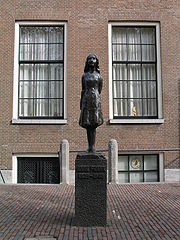
Anne Frank
Annelies Marie "Anne" Frank is one of the most renowned and most discussed Jewish victims of the Holocaust. Acknowledged for the quality of her writing, her diary has become one of the world's most widely read books, and has been the basis for several plays and films.Born in the city of Frankfurt...
, almost completely wiping out the Jewish community. Before the war, Amsterdam was the world's center for the diamond trade. Since this trade was mostly in the hands of Jewish businessmen and craftsmen, the diamond trade essentially disappeared.
Amsterdam made a bid for the 1952 Olympic Games (summer games) but was unsuccessful. The games went to Helsinki.
The cultural revolution of the 1960s and 1970s made Amsterdam the magisch centrum (magical centre) of Europe. The use of soft drugs was tolerated and this policy made the city a popular destination for hippies. Squat
Squatting
Squatting consists of occupying an abandoned or unoccupied space or building, usually residential, that the squatter does not own, rent or otherwise have permission to use....
ting became widespread. Riots and clashes with the police were frequent. A grim atmosphere took hold of Amsterdam. Anarchists, such as the Provos and a local political movement Kabouterbeweging, wanted to change the local society. Squatting of empty buildings and buildings used for other purposes than living led to a strong confrontation with contractors, who were aligned with the Dutch Mafia. The construction of the underground Metro
Amsterdam Metro
The Amsterdam Metro is a mixed rapid transit and light rail system in Amsterdam, and its surrounding municipalities Amstelveen, Diemen, and Ouder-Amstel in the Netherlands. The network is owned by the city of Amsterdam and operated by the Gemeentelijk Vervoerbedrijf, the company that also operates...
under the oldest parts of the city also led to widespread protests due to the impact of the construction on heritage buildings and local residents. Amsterdam started the 1980s in an explosive manner. In 1980, while Queen Beatrix
Beatrix of the Netherlands
Beatrix is the Queen regnant of the Kingdom of the Netherlands comprising the Netherlands, Curaçao, Sint Maarten, and Aruba. She is the first daughter of Queen Juliana of the Netherlands and Prince Bernhard of Lippe-Biesterfeld. She studied law at Leiden University...
's coronation was being held in the New Church on Dam square, protesters outside the church fought with the police in protest against government policies. Their slogan was 'Geen woning, geen kroning' (No house, no coronation). The mayor and city council eventually had to bring in the military to get the situation under control.
During the 1970s the number of foreign immigrants, primarily from Suriname, Turkey and Morocco grew strongly. This led to an exodus of people to the 'growth cities' of Purmerend
Purmerend
Purmerend is a municipality and a city in the Netherlands, in the province of North Holland.The city is surrounded by polders, such as the Purmer, Beemster and the Wormer. The city became the trade center of the region but the population grew relatively slow. Only after 1960 did the population...
, Almere
Almere
Almere is a planned city and municipality in the province of Flevoland, the Netherlands, bordering Lelystad and Zeewolde. The municipality of Almere comprises the districts Almere Stad, Almere Haven, Almere Buiten, Almere Hout, Almere Poort and Almere Pampus .Almere is the youngest city in the...
and other cities near Amsterdam. However, neighbourhoods like the Pijp and the Jordaan, which had previously been working class, became sought out places of residence for the newly wealthy yuppie
Yuppie
Yuppie is a term that refers to a member of the upper middle class or upper class in their 20s or 30s. It first came into use in the early-1980s and largely faded from American popular culture in the late-1980s, due to the 1987 stock market crash and the early 1990s recession...
s and students. Amsterdam that used to be a poor city in the Netherlands turned into an economically rich city thanks to the new economical trend towards a service-economy instead of an industrial economy.
In 1992, an El Al
El Al
El Al Israel Airlines Ltd , trading as El Al , is the flag carrier of Israel. It operates scheduled domestic and international services and cargo flights to Europe, North America, Africa and the Far East from its main base in Ben Gurion International Airport...
cargo plane crashed in the Bijlmermeer in Amsterdam Zuidoost
Amsterdam Zuidoost
Amsterdam-Zuidoost is one of fifteen boroughs of the city of Amsterdam. It consists of four residential areas—Bijlmermeer, Venserpolder, Gaasperdam and Driemond—as well as the Amstel III/Bullewijk Business Park and the ArenA Boulevard area.Amsterdam-Zuidoost has approximately 86,000...
. This disaster, called the Bijlmerramp, caused the death of at least 43 people.
At the beginning of the millennium social problems such as safety, ethnic discrimination and segregation between religious and social groups began to develop. 45% of the population of Amsterdam has non-Dutch parents. Large social groups are people from Surinam, the Dutch Antilles, Morocco and Turkey. Amsterdam is characterized by its (perceived) social tolerance and diversity. The social tolerance was endangered by the murder of Dutch film-maker Theo van Gogh
Theo van Gogh (film director)
Theodoor "Theo" van Gogh was a Dutch film director, film producer, columnist, author and actor.Van Gogh worked with the Somali-born writer Ayaan Hirsi Ali to produce the film Submission, which criticized the treatment of women in Islam and aroused controversy among Muslims...
on 2 November 2004 by a Mohamed Bouyeri, an islamic fundamentalist. The mayor of Amsterdam, Job Cohen
Job Cohen
Marius Job Cohen is a Dutch social democratic politician and former legal scholar of Jewish background. Since 2010 he has been the leader of the Labour Party and since June 17, 2010 he has been a member of the House of Representatives, where he also is the Parliamentary group leader of the Labour...
, and his alderman for integration Ahmed Aboutaleb
Ahmed Aboutaleb
Ahmed Aboutaleb is a Dutch politician of the Labour Party . He has been the Mayor of Rotterdam since January 5, 2009...
formulated a policy of "keeping things together" which involves social dialogue, tolerance and harsh measures against those who break the law.
Cultural life
In the 15th and 16th century cultural life in Amsterdam consisted mainly of festivals. During the later part of the 16th century Amsterdams Rederijkerskamer (Chamber of RhetoricChamber of rhetoric
Chambers of rhetoric were dramatic societies in the Low Countries. Their members are called Rederijkers , from the french word 'rhétoricien', and during the 15th and 16th centuries were mainly interested in dramas and lyrics...
) organized contests between different Chambers in the reading of poetry and drama. In 1638 Amsterdam got its first theatre. Ballet
Ballet
Ballet is a type of performance dance, that originated in the Italian Renaissance courts of the 15th century, and which was further developed in France and Russia as a concert dance form. The early portions preceded the invention of the proscenium stage and were presented in large chambers with...
performances were given in this theatre as early as 1642. In the 18th century French theatre became popular. Opera could be seen in Amsterdam from 1677, first only Italian and French operas, but in the 18th century German operas. In the 19th century popular culture was centered around the Nes area in Amsterdam (mainly vaudeville
Vaudeville
Vaudeville was a theatrical genre of variety entertainment in the United States and Canada from the early 1880s until the early 1930s. Each performance was made up of a series of separate, unrelated acts grouped together on a common bill...
and musichall). The metronome
Metronome
A metronome is any device that produces regular, metrical ticks — settable in beats per minute. These ticks represent a fixed, regular aural pulse; some metronomes also include synchronized visual motion...
, one of the most important advances in European classical music was invented here in 1812 by Dietrich Nikolaus Winkel
Dietrich Nikolaus Winkel
Dietrich Nikolaus Winkel was the inventor of the first successful metronome. He also invented the componium, an automatic instrument that could make endless variations on a musical theme....
. At the end of this century the Rijksmuseum
Rijksmuseum
The Rijksmuseum Amsterdam or simply Rijksmuseum is a Dutch national museum in Amsterdam, located on the Museumplein. The museum is dedicated to arts, crafts, and history. It has a large collection of paintings from the Dutch Golden Age and a substantial collection of Asian art...
and Gemeentelijk Museum were built. In 1888 the Concertgebouworkest was established. With the 20th century came cinema, radio and television. Though the studios are in Hilversum
Hilversum
is a municipality and a town in the Netherlands, in the province of North Holland. Located in the region called "'t Gooi", it is the largest town in that area. It is surrounded by heathland, woods, meadows, lakes, and smaller villages...
and Aalsmeer
Aalsmeer
Aalsmeer is a municipality and a town in the Netherlands, in the province of North Holland. Its name is derived from the Dutch for eel and lake . Aalsmeer is bordered by the Westeinderplassen lake, the largest open water of the Randstad, and the Ringvaart Canal...
, Amsterdams influence on programming is very strong. After World War II popular culture became the dominant cultural phenomenon in Amsterdam.
History of the municipality
When the municipality was created during the French occupation, it covered the city (then consisting of only the central part inside the canals) and the immediate surroundings, less than 10% of the current municipality. When the city grew, it annexed several neighbouring municipalities:- Sloten (covering the villages of Sloten, Sloterdijk and Osdorp, in the west), annexed in 1921
- BuikslootBuikslootBuiksloot is a former village in the Dutch province of North Holland. It is now a neighbourhood of Amsterdam-Noord.Buiksloot was a separate municipality until 1921, when it was merged with Amsterdam....
, annexed in 1921, now part of Amsterdam-Noord - NieuwendamNieuwendamNieuwendam is a former village in the Dutch province of North Holland. It is now a neighbourhood of Amsterdam-Noord.Nieuwendam was a separate municipality until 1921, when it was merged with Amsterdam. The municipality covered the villages of Nieuwendam and Zunderdorp.-External links: Map of the...
(covering Nieuwendam and Zunderdorp), annexed in 1921, now part of Amsterdam-Noord - Ransdorp (covering Ransdorp, Schellingwoude, Durgerdam and Holysloot), annexed in 1921, now part of Amsterdam-Noord
- WatergraafsmeerWatergraafsmeerThe Watergraafsmeer is a polder in The Netherlands. It was reclaimed in 1629. In the 17th and 18th centuries, there were many buitenplaatsen in the Watergraafsmeer, though nowadays only one, Frankendael, remains....
, annexed in 1921 - a part of Nieuweramstel (covering the village of Buitenveldert)
- a part of WeesperkarspelWeesperkarspelWeesperkarspel is a former municipality in the Dutch province of North Holland. It existed until 1966, when part of it was merged with Amsterdam and the part East of the Amsterdam-Rhine Canal was merged with Weesp....
(covering the Bijlmermeer and the village of Driemond), annexed in 1966, now Amsterdam-Zuidoost
In 1995, the national government proposed the creation of a 'city province', consisting of Amsterdam and neighbouring towns. This was rejected by the people in a referendum
Referendum
A referendum is a direct vote in which an entire electorate is asked to either accept or reject a particular proposal. This may result in the adoption of a new constitution, a constitutional amendment, a law, the recall of an elected official or simply a specific government policy. It is a form of...
. The opposition was not so much against creating the city province, but against the splitting of the city in parts. Opposers feared this would destroy the city's cohesion. After the referendum the city province proposal was shelved. Nevertheless, since 1995, city parts have gradually become more autonomous, and neighbouring towns have been drawn into the city, politically and economically. In a sense, the city province has arrived in the form of 'Greater Amsterdam'.
Further reading
- Israel, Jonathan I. The Dutch Republic, Its Rise, Greatness, and Fall 1477-1806 (1995) excerpt and text search
- Regin, Derek. Traders, artists, burghers: A cultural history of Amsterdam in the 17th century (1976)
- Roekholt, Richter. A short history of Amsterdam (2004)
- Schama, Simon. The Embarrassment of Riches: An Interpretation of Dutch Culture in the Golden Age (1997)

